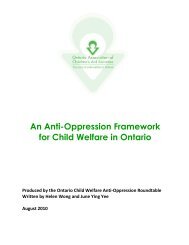English - Ontario Association of Children's Aid Societies
English - Ontario Association of Children's Aid Societies
English - Ontario Association of Children's Aid Societies
Create successful ePaper yourself
Turn your PDF publications into a flip-book with our unique Google optimized e-Paper software.
USE OPEN COMMUNICATION<br />
The greater the engagement <strong>of</strong> the family as a partner, the greater the likelihood that<br />
the family will view child welfare as a helper towards positive change. Focus group<br />
participants felt that the current way that CAS communicates is to withhold<br />
information and shows disrespect.<br />
USE QUESTIONS THAT SHOW RESPECT<br />
In order to perform an accurate assessment and build a positive relationship, the<br />
child welfare pr<strong>of</strong>essional will need to ask questions <strong>of</strong> the family. To promote respect,<br />
structure questions in a way that builds on the family’s history,<br />
culture and background, recognizing the family as the experts in<br />
their life. If the family’s answers are not clear, ask deeper questions.<br />
A family that is knowledgeable about their culture, for example,<br />
could be asked:<br />
> > What is important to you as you raise this child What do<br />
you want to ensure is part <strong>of</strong> her upbringing<br />
> > In your community, what did the community do when a parent was not<br />
meeting his/her responsibilities<br />
When answers are not clear, ask<br />
deeper questions. Be prepared to<br />
answer the family’s questions.<br />
USE INTERVENTIONS THAT PROMOTE THE CIRCLE<br />
Alternative Dispute Resolution (ADR) processes are interventions that include<br />
family members, community representatives, Elders and other service providers to<br />
strengthen the circle <strong>of</strong> care for the family and child. ADR processes can be adapted to<br />
fit the needs <strong>of</strong> the family and include more service providers in the circle.<br />
Talking and Healing Circles are powerful tools that child welfare pr<strong>of</strong>essionals can<br />
use to engage families and communities. Circles help to equalize the power between<br />
child welfare pr<strong>of</strong>essionals and family members, and reinforces that child welfare,<br />
parents and community members are partners in making the family stronger.<br />
Using talking circles and asking questions that are solution-focused and meant to<br />
help strengthen families creates more opportunities for positive change in a family.<br />
CLOSE THE FILE EXPEDITIOUSLY<br />
Some participants expressed concern that child welfare took too long to close files<br />
for some families. Women who had been in an abusive relationship felt that many<br />
assumptions were made about them, including that they would let their children<br />
be exposed to violence again. While focus group participants recognized that child<br />
welfare must focus on the child and mother’s safety, they also felt that mothers were<br />
not engaged to help create their own safety responses for herself and her children.<br />
111

















